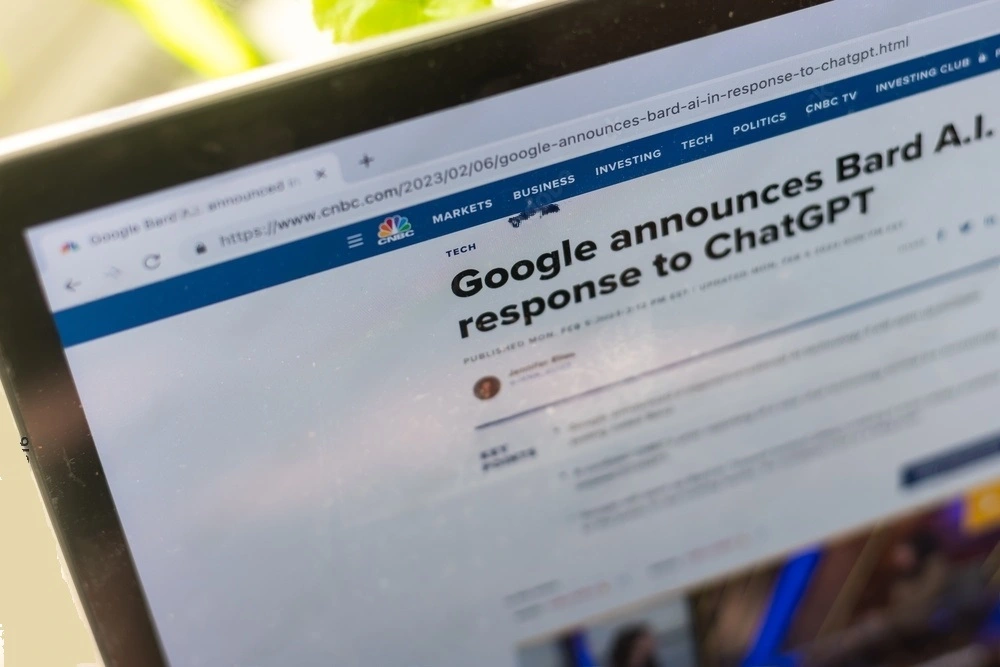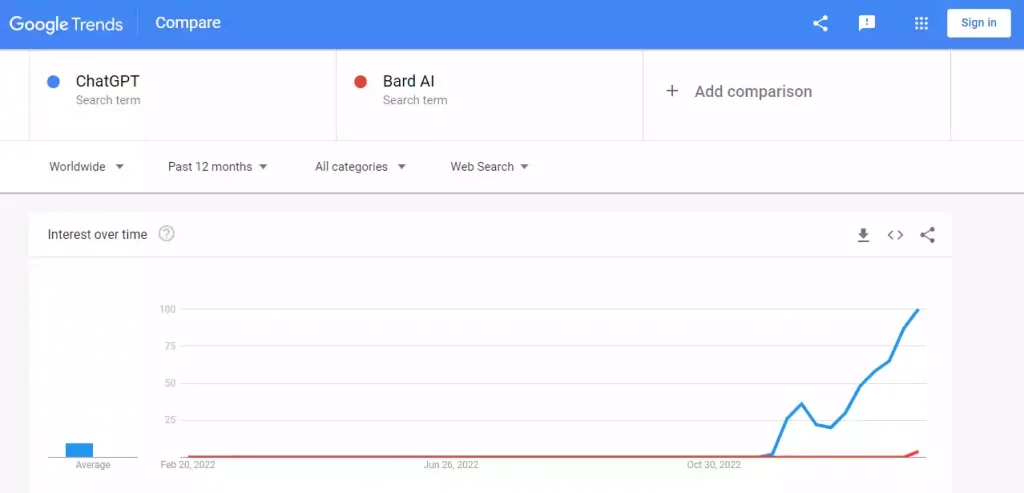ChatGPT Vs Bard: The Differences and the Early Verdict

Published on: February 10, 2023
Updated on: June 26, 2024
1049 Views
- Digital Marketing
20 min read
OpenAI's ChatGPT has been the most debated topic in the tech world. Since its launch, the AI-powered chatbot has been clocking interesting numbers. It touched a million users within the first five days and currently processes 10 million daily queries.
It has reached 100 million users in two months, and the numbers keep growing. Users have found creative ways to leverage this AI-powered world, from writing poems to creating content and even completing homework. Its cheerleaders have called it the "Google Search killer."
The bosses at Google's headquarters in Mountain View took this threat seriously. Not in the mood to give up their dominant position in the market, they have come up with their own conversational AI service, the Bard.
There have been early hiccups due to this hastened launch, with Alphabet Inc. losing $100 billion in the market cap as the chatbot came up with an incorrect answer in the promotional video! Nevertheless, the search engine giant will surely fix the bugs and give ChatGPT a run for its money.
Interestingly, Microsoft has put its hat behind ChatGPT in a bid to take on its long-term rival, Google, and this will make the AI-powered generative content space even more interesting in the days and months to come. It brings us to the most important part of this piece – what are the differences between Google Bard AI and Chat GPT? Let's find out.

Language Generation Capabilities
In the world of AI language models, ChatGPT and BARD stand out for their remarkable ability to generate human-like text. However, when it comes to comparing them in terms of language generation capabilities, several factors come into play.
Performance Evaluation:
When it comes to evaluating performance, both ChatGPT and BARD excel in certain aspects. In terms of quality, they deliver text that often appears indistinguishable from human-generated content. The coherence of their responses is also impressive, as they produce logical and contextually relevant text. Additionally, their fluency in generating coherent sentences demonstrates an advanced understanding of grammar and syntax.
What sets them apart is creativity. While both models possess creative language generation skills, BARD tends to exhibit a slightly higher degree of imaginative output. This can be attributed to its training data, which includes a diverse range of sources ranging from classic literature to modern poetry.
Examples Showcasing Differences:
Let's compare the language generation abilities of ChatGPT and BARD through a few examples:
- Example 1 - Topic: Space Exploration
ChatGPT: "Space exploration has led to numerous discoveries that have revolutionized our understanding of the universe."
BARD: "In the depths of cosmic realms, humanity embraced the unknown, unraveling mysteries and expanding horizons through the audacity of exploration." - Example 2 - Topic: Childhood Memories
ChatGPT: "Playing in the park with friends brings back fond memories of my childhood."
BARD: "As giggles echoed through sun-drenched meadows, innocence and joy intertwined like blossoms dancing in the gentle breeze, etching memories that glow in the gentle corners of the heart." - Example 3 - Topic: Artificial Intelligence
ChatGPT: "Artificial intelligence is rapidly transforming industries across the globe."
BARD: "Within the cyberspace's embrace, the silvery tendrils of artificial intelligence stretch their reach, reshaping the world with algorithms that dance in virtual symphonies, orchestrating a future yet unwritten."
These examples showcase how both models generate impressive text, but BARD's output often adds an artistic and poetic flair.
Difference Between Google Bard AI and ChatGPT
Both Bard and ChatGPT are language-based conversational AI models. From a user perspective, they can generate content based on basic queries. However, there are differences in how they generate responses and their limitations. Here are the key differences between OpenAI's ChatGPT and Google's Bard -
1. Language
ChatGPT is powered by the GPT (Generative Pre-Trained Transformer – 3) language model, which trains and feeds the large dataset. All responses generated using this tool would be based on the dataset or text blended into the code.
To improve its generative content, ChatGPT regularly collects data from its users, which is used to train and fine-tune the language model. Google's Bard draws its power from the patented Language Model for Dialogue Applications (LaMDA). It draws data from the Internet and has access to more data.
2. Response Generation
There is a fundamental difference in the way these two chatbots generate information. As you already know, ChatGPT doesn't use the Internet to generate responses. A large data set that runs into 570 GB or 300 billion words powers its responses.
ChatGPT generates all its responses from the information available in this data set. On the other hand, Google relies on its core strength, the search engine, to generate responses. It doesn't generate responses from a static data set but uses publicly available information to generate answers to queries.
3. Relevance of Information
ChatGPT's knowledge set is limited to information available till 2021. Open AI had stated that the knowledge base was limited to 2021, and they plan to update it with time. We don't have clarity on whether the knowledge base has seen any updates since its launch.
Hence, all responses generated using ChatGPT have limited knowledge until 2021 and can't be used to generate responses on current topics. On the other hand, Google uses the Internet to generate responses; hence, its response is technically more relevant and up-to-date.
4. Limitations
Both these AI-powered platforms have their limitations regarding the quality of responses they generate. However, these limitations are different thanks to their distinct approaches to data collection. Since ChatGPT relies on its dataset for generating responses, its output is limited by data biases.
Its responses are generated based on the knowledge of that subject till the cutoff date. Google Bard, on the other hand, is limited by Internet biases. Since it generates a response using publicly available information, it can promote fake news and narratives.

Training Data Analysis
In order to understand the capabilities and behavior of ChatGPT and BARD, it is important to examine the sources, sizes, and types of training data that these models are built upon. The training data used for both ChatGPT and BARD has a significant impact on their performance, biases, and overall behavior.
Examination of the sources, sizes, and types of training data used for ChatGPT and BARD
ChatGPT and BARD both utilize vast amounts of training data to learn patterns and generate text. However, there are differences in the sources, sizes, and types of training data used for these models.
ChatGPT's training data consists of a diverse range of sources, including books, websites, and other publicly available text from the internet. The training dataset for ChatGPT consists of approximately 45 terabytes of text data, making it one of the largest training datasets ever used for language generation.
BARD, on the other hand, relies on a narrower set of sources for training data. It primarily uses dialogues and conversations from the OpenAI community forum, as well as a selection of articles from the internet. The training dataset for BARD is significantly smaller compared to ChatGPT, consisting of approximately 6 terabytes of text data.
Impact of training data on the behavior and biases of both models
The training data plays a crucial role in shaping the behavior and biases of ChatGPT and BARD. Both models tend to mirror the patterns and biases present in the input data, which can lead to biased or misleading outputs.
For example, if the training data contains biased language or information from specific sources, the generated responses from both models may reflect those biases. Similarly, if the training data lacks diversity or includes harmful content, it can influence the behavior of the models.
It is important to acknowledge that biases in training data can unintentionally manifest in the outputs of these models, despite efforts to mitigate them. OpenAI recognizes the need for ethical considerations when selecting and using training data to minimize biases and ensure responsible AI development.
Ethical considerations related to training data selection and potential biases
Training data selection must be guided by ethical considerations to avoid amplifying biases and perpetuating harmful stereotypes. OpenAI acknowledges the challenges associated with training large language models and is actively working towards addressing these concerns.
OpenAI is committed to improving the clarity of instructions given to human reviewers who assist in the training process to avoid potential pitfalls and biases. They also aim to provide clearer guidelines to reviewers about potential bias-related issues.
OpenAI encourages feedback and suggestions from users and the wider community to enhance their understanding of biases and develop mechanisms to tackle them effectively. They prioritize the responsible use and deployment of AI systems and are continually striving to reduce both glaring and subtle biases in the outputs of ChatGPT and BARD.
Technical Differences: Model Architecture
When it comes to the technical aspects of ChatGPT and BARD, there are several differences in their model architecture that set them apart. Let's dive into these differences to get a better understanding of how each model works.
Comparison of Model Sizes, Layers, and Design Choices
One distinctive difference between ChatGPT and BARD lies in their model sizes. ChatGPT is built on a large-scale transformer-based language model, consisting of multiple layers of self-attention and feed-forward neural networks. On the other hand, BARD employs a similar architecture but with a relatively smaller model size, allowing for quicker inference times and reduced resource requirements.
Additionally, the number of layers in each model differs as well. ChatGPT utilizes a deeper architecture with a higher number of layers, enabling it to capture intricate dependencies across a wide range of input sequences. In contrast, BARD has a shallower architecture with fewer layers, making it well-suited for tasks that prioritize faster response times.
Design choices in the two models also contribute to their technical disparities. While both models use self-attention mechanisms to weigh the importance of different words in a given context, the specific implementation details may vary. Additionally, the choice of activation functions, regularization techniques, and other architectural decisions can also differ, resulting in distinct behavior and performance.
Effect on Performance and Behavior
These technical differences significantly impact the performance and behavior of ChatGPT and BARD in various contexts. The larger model size and deeper architecture of ChatGPT allow it to generate more detailed and coherent responses in complex situations. However, this can also lead to occasional verbosity or overuse of template-like phrases.
On the other hand, BARD's smaller model size and shallower architecture make it more suitable for real-time applications that require quick responses. It excels at providing concise and to-the-point answers. However, its responses may lack the same level of detailed context and coherence seen in ChatGPT's output.
It's important to note that both models undergo continual updates and improvements, aiming to enhance their performance and address any limitations introduced by their respective architectures. This ongoing development further enables fine-tuning the models for specific use cases and applications.
Use Cases and Applications
ChatGPT and BARD have a wide range of potential applications, making them versatile and valuable tools in various industries. Here are some examples of how these models can be utilized:
Customer Support
Both ChatGPT and BARD can be employed in customer support applications to provide prompt and accurate responses to customer inquiries. Their language generation capabilities enable them to understand customer queries and offer helpful solutions or information.
Content Generation
These models can also be used for content generation purposes. Whether it's writing blog posts, articles, or social media updates, ChatGPT and BARD can assist in creating engaging and informative content. With their ability to comprehend context and generate coherent text, they can save time and effort for content creators.
Virtual Assistants
ChatGPT and BARD have the potential to function as virtual assistants, providing helpful and conversational interactions. By understanding user queries and providing accurate responses, they can provide assistance in various tasks, such as scheduling appointments, providing recommendations, or answering general questions.
Storytelling
Both models have the ability to generate text that tells a story. They can be utilized in interactive storytelling applications, where users can engage with the model to create unique and personalized narratives. This opens up possibilities for immersive storytelling experiences in gaming, entertainment, or educational platforms.
Real-world success stories have already emerged from the utilization of ChatGPT and BARD. For instance, in customer support applications, companies have reported significant improvements in response time and customer satisfaction. Content creators have seen increased productivity and creativity in their writing workflow. Virtual assistants powered by these models have provided users with seamless and natural interactions. Additionally, interactive storytelling platforms have benefited from enhanced user engagement and personalized experiences.
The applications of ChatGPT and BARD are vast and continually expanding as developers integrate them into innovative solutions. The versatility and effectiveness of these models make them valuable assets in a variety of industries.
Ethics and Bias Mitigation
When it comes to language generation models like ChatGPT and BARD, it is crucial to address the fairness and ethical concerns associated with them. OpenAI understands the importance of mitigating biases in these models and has implemented strategies to tackle these issues.
Analysis of the fairness and ethical concerns related to ChatGPT and BARD
Language models have the potential to propagate biases present in their training data. ChatGPT and BARD are no exceptions to this concern. Due to their large-scale training, they may inadvertently learn biased or discriminatory patterns present in the data, leading to biased outputs.
The concerns primarily revolve around biased attitudes, stereotypes, or harmful narratives that might be perpetuated by these models. It is crucial to address these issues to ensure the responsible and ethical use of AI-powered language generation systems.
Strategies employed by OpenAI to mitigate biases in the models
OpenAI acknowledges the challenge of bias mitigation and continues to make efforts to improve the fairness of ChatGPT and BARD. They employ multiple strategies to tackle biases:
- Dataset Curation: OpenAI actively works on curating diverse and inclusive training datasets to minimize biases and discriminatory content. By including a wide range of perspectives and sources, they aim to reduce the potential for biased outputs.
- Guidelines and Decision-Making: OpenAI provides explicit instructions to human reviewers about potential biases and ethical concerns, emphasizing the importance of avoiding favoring any specific political group, promoting violence, or generating harmful content. Regular feedback loops and discussions help address biases and improve the model's behavior.
- User Feedback: OpenAI encourages users to provide feedback on problematic model outputs. This feedback helps in identifying and rectifying biases, making the system more reliable and fair over time.
Discussion on ongoing efforts and challenges in addressing ethical concerns
While OpenAI has made significant strides in addressing ethical concerns and mitigating biases in ChatGPT and BARD, it remains an ongoing challenge. The dynamic nature of language and the vastness of training data make it challenging to completely eradicate biases. Ongoing research and development are crucial in improving the models' behavior and minimizing ethical concerns.
Additionally, OpenAI acknowledges the need for transparency and accountability. They continue to seek external input through red teaming, conducting third-party audits, and partnering with external organizations to identify and address biases and ethical concerns.
User Feedback and Improvements
At OpenAI, we value user feedback and continuously strive to improve our models based on the insights and suggestions provided by our users. This section highlights some of the valuable user feedback, ideas for improvement, and experiences shared by our users regarding both ChatGPT and BARD.
User Feedback: Ideas for Improving ChatGPT and BARD
- Improved model responsiveness for faster generation of output
- Enhanced support for multi-turn conversations
- Better understanding of nuanced queries and context
- Greater flexibility and control in customizing model behavior
- More coherent and accurate responses in challenging scenarios
User Experiences: Areas of Improvement and Impressive Features
Many users have shared their experiences with ChatGPT and BARD, highlighting areas where improvements can be made, as well as the impressive features they have observed. Key feedback and experiences include:
- Occasional output inconsistency in ChatGPT, which can be addressed to improve reliability
- The ability of ChatGPT to provide insightful and creative suggestions for various tasks and creative writing
- BARD's impressive knowledge base and its potential for aiding in research, brainstorming, and content creation
- User appreciation for the models' ability to assist with generating code snippets, summaries, and responses in real-time
OpenAI's Response and Plans for Model Enhancement
OpenAI carefully considers user feedback and aims to enhance both ChatGPT and BARD based on the valuable input received. Plans for model improvement include:
- Investing in research and development to address the identified areas of improvement
- Continuously refining the training process to reduce biases and improve model behavior
- Providing regular updates and incorporating user feedback to ensure a more seamless user experience
- Creating clear guidelines and mechanisms to allow users to customize the models based on their specific needs
Integration and APIs
Integrating ChatGPT and BARD into your applications has never been easier. With their availability and easy-to-use APIs, developers and researchers can seamlessly incorporate the power of these technologies into their projects.
Practical aspects of integrating ChatGPT and BARD into applications
Integrating ChatGPT and BARD into your applications is a straightforward process. These state-of-the-art language models can be accessed through their respective APIs, allowing you to leverage their powerful text generation capabilities.
By making API calls to ChatGPT and BARD, you can generate natural language responses, chat interactions, and much more. Their integration is versatile and can be customized based on your application's specific requirements.
Availability and usage of APIs for developers and researchers
Both ChatGPT and BARD provide developers and researchers with comprehensive APIs to facilitate seamless integration. These APIs offer a wide range of functionalities, making it easy to incorporate the models into various applications.
Developers and researchers can access the APIs, explore the documentation, and familiarize themselves with the capabilities and usage guidelines. The APIs provide detailed information on how to interact with the models, allowing for a smooth integration process.
Examples of successful integrations and applications powered by ChatGPT and BARD
ChatGPT and BARD have already been successfully integrated into various applications with impressive results. Their versatile nature allows them to be employed across multiple domains and use cases.
Take customer support, for example. Companies have integrated ChatGPT and BARD into their chat systems, providing customers with prompt and personalized responses. This not only improves customer satisfaction but also enhances efficiency by automating the support process.
Additionally, researchers have utilized ChatGPT and BARD in their projects to generate human-like text, aiding in various language-related tasks. From creative writing assistance to language translation, these models have proved to be valuable tools.
The success stories and impactful applications of ChatGPT and BARD continue to grow, showcasing their immense potential for integration and innovation.
Benchmarking and Comparative Analysis
When it comes to language models, it's important to evaluate their performance, strengths, weaknesses, and specific use cases. In this section, we will conduct a comparative analysis of ChatGPT and BARD against other popular language models such as GPT-3 or BERT.
Comparative Analysis of ChatGPT and BARD
During the benchmarking process, we evaluated both ChatGPT and BARD on various parameters to determine their capabilities.
- Performance: Both ChatGPT and BARD demonstrated exceptional performance in generating coherent and contextually relevant text across different domains and topics.
- Strengths: One of the significant strengths of ChatGPT is its ability to engage in long and meaningful conversations, making it perfect for chatbot applications. On the other hand, BARD stands out in generating creative and narrative-rich content, making it ideal for storytelling or content generation purposes.
- Weaknesses: While ChatGPT showcases impressive conversational abilities, its responses can sometimes be overly verbose or fail to provide concrete answers. BARD, while excelling in narrative text generation, may occasionally produce less coherent responses in certain situations.
- Specific Use Cases: ChatGPT shines in customer support chatbots, virtual assistants, and interactive conversational agents. BARD, on the other hand, is an excellent choice for generating engaging narratives, writing assistance, or even creative writing prompts.
Insights gained from our comparative analysis indicate that both ChatGPT and BARD offer unique advantages compared to other language models.
Unlike GPT-3, ChatGPT focuses specifically on conversational contexts, providing more engaging and interactive conversations. BERT, on the other hand, primarily focuses on understanding language semantics and may not excel in generating creative or narrative content like BARD does.
Overall, ChatGPT and BARD are distinguished by their specialized capabilities, making them stand out in their respective use cases and outperforming other language models.
Future Development and Advancements
The development of ChatGPT and BARD continues to progress, with OpenAI exploring future directions and potential upgrades for these models. As these language generation models gain popularity and are adopted in various domains, there are high expectations for new features, enhanced performance, and expanded capabilities.
OpenAI is committed to continuously improving ChatGPT and BARD based on user feedback and the analysis of training data. With the knowledge gained from user interactions and benchmarking, OpenAI aims to address biases, improve the response quality, and mitigate ethical concerns associated with these models.
The anticipation of OpenAI's plans and roadmap for the development of ChatGPT and BARD is met with excitement. The community expects OpenAI to explore novel techniques and expand the models' ability to handle a wider range of tasks and understanding of context. Future advancements might include better contextual understanding, refined language generation, and enhanced domain-specific capabilities.
OpenAI's commitment to transparency and collaboration fosters the expectation of sharing progress and updates regarding the development of these models. The community eagerly awaits the release of research findings, technical improvements, and potential upgrades. The future development of ChatGPT and BARD is poised to revolutionize the field of language generation and shape the way we interact with AI models.
What is The Early Verdict?
ChatGPT has been open to users and has been thoroughly tested by users in the last three months. Though it is yet to become an alternative to human-generated content, it has found its use as a research tool for content creators.
Bard is available only to a select group of testers, and people have yet to try this tool. It has had its problems, as we had stated earlier. The verdict isn't out yet, but Bard needs to be good for Google to retain its position as the world's most trusted research and information platform.
Conclusion
As mentioned above, ChatGPT and Bard have their share of differences based on how they generate content. Both these AI-powered tools have ushered in a new era of generative content, and we expect the world to change for content creators and the marketing industry.
We are in the early days of generative content, with ChatGPT taking baby strides while Bard is still unavailable for public use. Google is testing this tool thoroughly before it is made available for users and the API version releases for businesses.
These models, with their distinct architectures and capabilities, play a significant role in revolutionizing the conversational AI chatbot landscape. The implications and impact of ChatGPT and BARD are profound, empowering internet users with powerful generative information tools.
Looking ahead, the development and advancements in both models hold great promise. As OpenAI continues to refine and expand upon these language generation technologies, internet users can anticipate even more sophisticated conversational experiences and access to reliable information.
As a business, you need to embrace Artificial Intelligence in your marketing campaigns, and the latest developments signal the AI era has truly arrived. At Growth Natives, we have used AI-powered tools to power marketing campaigns. If you wish to leverage the power of AI, set up a consultation with our team by emailing us at info@growthnatives.com.



